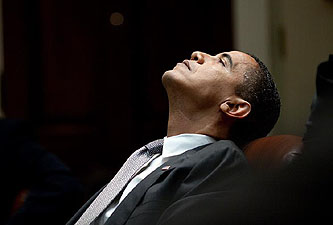While I was in New York I met up with one of my longtime readers (and a fellow cat lover — see Coco at the very bottom of 2009’s Holiday Catblogging Extravaganza) and we were joined by Stuart Zechman, who you may recognize as a regular guest on Jay Ackroyd’s Virtually Speaking. We got to talking about Barack Obama and ended up in some very airy,  meta, navel-gazing territory that I thought I might toss out for comment. This isn’t usually my thing, and it might not be yours either. If it isn’t, don’t stress out about it. Just skip it and scroll down to the next post.
meta, navel-gazing territory that I thought I might toss out for comment. This isn’t usually my thing, and it might not be yours either. If it isn’t, don’t stress out about it. Just skip it and scroll down to the next post.
Anyway. Obama. At some point in our conversation one thing led to another and I offered up the conventional view that Obama is a center leftist. Stuart disagreed: Obama, he thinks, is a pure centrist, full stop. Now, I’m convinced that by every normal measure of these things, I’m right. Obama is, plainly, to the left of —
Well, what? This is where things broke down a bit. How do you measure this?
There’s Obama’s Senate voting record, of course, which by multiple measures put him in the leftmost quarter of the Senate. But that’s the Senate. It doesn’t say anything about his performance as president.
Or there’s Obama compared to some mythical median voter. But that’s almost undefinable. Obama pushed to repeal DADT, but by the time he did, repeal was supported by more than half the country. So you could say that repeal was actually a centrist position. By that definition, however, pretty much everything supported by a majority of the country is “centrist.” Tax cuts are centrist. The Iraq War was centrist. FDR was centrist. This gets you nowhere.
Or there’s conventional wisdom. Keynesian stimulus is leftist, national healthcare is leftist, and financial reform is leftist. So if you do moderate versions of those three things than you’re a moderate leftist. President McCain wouldn’t have done any of them, after all.
I’ll stop now. Like I said, this is the kind of airy metapolitical discussion that I usually don’t have a lot of patience for, and I think that by almost any measure Obama is obviously left of center. Still, it brings up a good question: it’s relatively easy to look at a legislator and get a fairly rigorous, quantitative read on how far left or right they are. But how about presidents? Aside from gut instinct and conventional wisdom, what’s the best measure of their political leanings? Anyone want to take a stab at this?


















